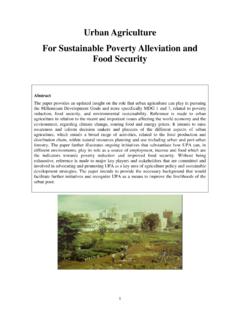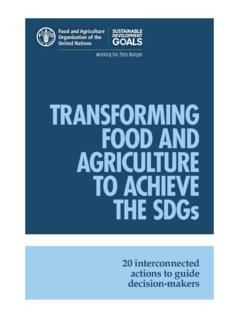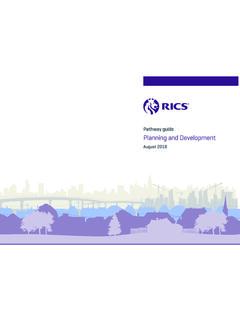Transcription of March 2015 Towards integration at last? The sustainable ...
1 DESA Working Paper No. 141ST/ESA/2015/DWP/141 March 2015 Towards integration at last? The sustainable development goals as a network of targetsDepartment of Economic & Social AffairsDavid Le Blanc David Le Blanc is Senior sustainable development Officer in the Division for sustainable development , United Nations Department of Economic and Social Affairs, UN DESA (email: 2014, UN Member States proposed a set of sustainable development goals (SDGs), which will succeed the Millennium development goals (MDGs) as reference goals for the interna-tional development community for the period 2015-2030. The proposed goals and targets can be seen as a network, in which links among goals exist through targets that refer to multiple goals . Using network analysis techniques, we show that some thematic areas covered by the SDGs are well connected among one another. Other parts of the network have weaker connec-tions with the rest of the system.)
2 The SDGs as a whole are a more integrated system than the MDGs were, which may facilitate policy integration across sectors. However, many of the links among goals that have been documented in biophysical, economic and social dimensions are not explicitly reflected in the SDGs. Beyond the added visibility that the SDGs provide to links among thematic areas, attempts at policy integration across various areas will have to be based on studies of the biophysical, social and economic Classification: O1 (Economic development ), O19 (International Linkages to Develop-ment, role of International Organizations), O20 ( development Planning and Policy: General).Keywords: sustainable development goals , SDGs, policy integration , sustainable develop-ment, development , science-policy Introduc tion ..12. Methodology ..23. The SDGS as a network of targets ..34. The SDGs as an enabler for integration ? ..95 Where are the gaps?.
3 116. Conclusion ..15 References ..17UN/DESA Working Papers are preliminary documents circulated in a limited number of copies and posted on the DESA website at to stimulate discussion and critical comment. The views and opinions expressed herein are those of the author and do not necessarily reflect those of the United Nations Secretariat. The designations and terminology employed may not conform to United Nations practice and do not imply the expression of any opinion whatsoever on the part of the : Nancy SettecasiUNITED NATIONSD epartment of Economic and Social AffairsUN Secretariat, 405 East 42nd StreetNew York, N .Y . 10017, USAe-mail: undesa@un .orghttp://www .un .org/en/ development /desa/papers/ 1 IntroductionIn 2014, following a decision taken at the Rio+20 Conference and after more than a year of intergov-ernmental work of what was called an Open Working Group, UN Member States proposed a set of Sustain-able development goals or SDGs (United Nations, 2014a).
4 The SDGs will succeed the Millennium De-velopment goals (MDGs) as reference goals for the international community for the period 2015-2030. The development of the new set of goals was widely seen as an ambitious challenge, as these goals cover a much broader range of issues than their predecessors, aim to be universal that is, applicable to all coun-tries and not only developing countries, and have to serve as guideposts for a difficult transition to sus-tainable development , which has eluded the interna-tional community since the Earth Summit in of integration across sectors in terms of strat-egies, policies and implementation has long been perceived as one of the main pitfall of previous approaches to sustainable development . Insufficient understanding and accounting of trade-offs and syn-ergies across sectors have resulted in incoherent poli-cies, adverse impacts of development policies focused on specific sectors on other sectors, and ultimately in diverging outcomes and trends across broad ob-jectives for sustainable development .
5 In terms of the MDGs for example, it is well acknowledged that many of the targets encapsulated in MDG7, which relates to environmental protection, have not been achieved and have in some cases been negatively impacted by policies and actions aiming to achieve other goals (United Nations, 2014b, 2014c; UNEP, 2012). Correspondingly, achieving greater inte-gration at various levels was a core concern of the international community at the Rio+20 conference, held on the 20th anniversary of the Earth Summit, and this is reflected in the outcome of the conference (United Nations, 2012a).More broadly, previous development agendas have been criticized for failing to fully integrate the key dimension of sustainable consumption and produc-tion (SCP), which was identified since the first Earth Summit as a key ingredient of sustainable develop-ment paths.
6 The political difficulty of addressing SCP issues, as well as its weak institutional anchoring due to its cross-cutting and systemic nature and lack of grounding of SCP considerations in other sector policies, have contributed to this outcome (Victor, 2008; Jackson, 2010; United Nations, 2011).This article explores the extent to which the struc-ture of the proposed goals and associated targets does indeed reflect the objective of better integration across sectors. The proposed goals and targets can be seen as a network, in which links among goals exist through targets that explicitly refer to multiple goals . The objective is to show where links between goals were made by the political process that created the SDGs. The resulting network and mapping, which reflect the results of negotiations in an intergovern-mental context, can be thought of as a political mapping of the sustainable development universe, as opposed to, for example, a mapping purely based on natural and social science insights about how the system works (see below).
7 Using network analysis techniques, I show how the SDGs seen through this lens are unequally connect-ed, with some goals being connected to many other goals through multiple targets, while other goals are weakly connected to the rest of the system. I show that two of the proposed goals , SDG 12 on sustain-able consumption and production (SCP) and SDG 10 on inequality, provide critical connections among other goals and make the SDGs more tightly linked as a network. The presence in the set of SDGs of targets that refer to multiple goals and sectors may facilitate integration and policy coherence across sectors, in particular at the level of international development agencies. Such links among goals through targets may also facilitate real mainstreaming of dimensions that previously suffered from not having strong sec-toral anchoring in development institutions, such as sustainable consumption and production.
8 However, our mapping also reveals that important links that exist among sustainable development areas through 2 DESA WORKING PAPER NO. 141the biophysical, social and economic systems are not explicitly reflected in the proposed remainder of this paper is built as follows. Sec-tion 2 describes the methodology used for the analy-sis. In section 3, I present the mapping of the SDGs as a network of related targets. Section 4 discusses the implication of the structure of the SDGs for cross-sectoral integration . Section 5 highlights some of the differences between the mapping presented here and other mappings of the sustainable develop-ment universe based on biophysical and socio-eco-nomic realities. Section 6 concludes. 2 MethodologyAs discussed above, the goals and targets propose by the OWG can be seen as a network, with links among goals through the targets. The proposal of the Open Working Group comes in the form of 17 goals , with several targets under each goal, amounting to a total of 169 targets.
9 The basis for the analysis presented here is a matrix that links every target of the SDGs to all the goals to which its wording refers. Thus, each target, in addition to be-ing linked with its own goal, may be linked to other goals . To take an example, target under goal 12 of the SDGs, Ensure sustainable consumption and production patterns , states: by 2020 achieve envi-ronmentally sound management of chemicals and all wastes throughout their life cycle in accordance with agreed international frameworks and significantly reduce their release to air, water and soil to minimize their adverse impacts on human health and the envi-ronment . This target explicitly refers to health, and is recorded as being linked to SDG 3, which reads: Goal 3. Ensure healthy lives and promote well-be-ing for all at all ages .A particularity of the SDGs as proposed by the Open Working Group is that under each of the goals , some of the proposed targets relate to the so-called means of implementation (in the sustainable development legislation that has come out of the Earth Summit, this term tends to encompass finance, trade, tech-nology transfer and capacity building).
10 A dedicated goal, SDG 17, was also dedicated to cross-cutting means of implementation for the whole set of SDGs. For the purpose of this paper, all the targets related to means of implementation are discarded from the analysis. One reason is that we want to focus on links between thematic areas. Another reason is that it is difficult to apply the methodology described above to targets relating to means of implementation. This is not, of course, to say that means of implementation across the set of SDGs do not deserve an analysis of their own. This restriction leaves us with 107 targets under 16 goals (all the SDGs except goal 17).1 This method, while seemingly straightforward, is of course subject to different interpretations of the wording of the targets. For example, whether a target referring to hygiene is recorded as having a link to the health goal depends on whether one considers that hygiene clearly and explicitly belongs to the health area.














